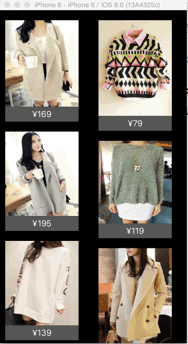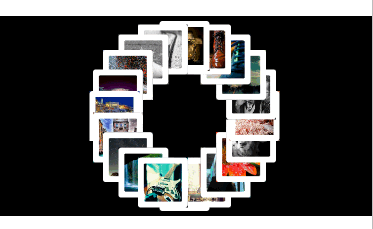
- 从零开始学习Object-C---第四天
- IOS开发代码分享之获取启动画面图片的string
- iOS开发之用javascript调用oc方法而非url
- 详细对比IB开发与纯手码开发的优劣。
- IOS开发--第四阶段--推送服务器的实现
- iOS——使用StroryBoard页面跳转及传值
- iOS开发日记31-Block终极篇
- UILabel自适应文本,让文本自适应
- 只一行显示可左右滚动的文本(UITextField中文限制)
- 基于XMPP协议的即时通信
- OC-19.GCD
- CocoaAsyncSocket使用
- OC - 9.基于Quartz2D绘制下载进度条(demo)
- iOS实现微信朋友圈与摇一摇功能
- IOS开发之由身份证号码提取性别的实现代码
- FoundationのNSString的常用方法
- (转)IOS学习笔记-2015-03-29int、long、longlong取值范围
- SwiftTour随笔总结(1)
- IOS开发之CocoaPods安装和使用教程
- 从零开始学ios开发(五):IOS控件(2),Slider
- IOSapp启动过程
- IOS开发之获取Storyboard创建的ViewController
- java学习之路—初级阶段(迷茫的大学)
- iOS-面试助攻(三)
- UINavigationController与UITabbarController的样式
- 使用Xcode为iOS应用项目创建PCH文件的方法及应用示例
- IOS键盘样式风格有关设置
- iOS开发日记5-推送(信鸽推送)
- iOS多线程及其他补充02
- 《iOS「通告机制」及由其引出的对「架构模式」、「设计模式」的理解
IOS实现自定义布局瀑布流
瀑布流是电商应用展示商品通常采用的一种方式,如图示例

瀑布流的实现方式,通常有以下几种
- 通过UITableView实现(不常用)
- 通过UIScrollView实现(工作量较大)
- 通过UICollectionView实现(通常采用的方式)
一、UICollectionView基础
1、UICollectionView与UITableView有很多相似的地方,如
- 都通过数据源提供数据
- 都通过代理执行相关的事件
- 都可以自定义cell,且涉及到cell的重用
- 都继承自UIScrollView,具有滚动效果
2、UICollectionView的特性
- 需要有一个UICollectionViewLayout类(通常是UICollectionViewFlowLayout类)或其子类对象,来决定cell的布局
- 可以实现UICollectionViewLayout的子类,来定制UICollectionView的滚动方向以及cell的布局
3、UICollectionViewLayout的子类UICollectionViewFlowLayout
- UICollectionViewFlowLayout即流水布局
- 流水布局UICollectionView的最常用的一种布局方式
二、自定义布局
1、自定义布局需要实现UICollectionViewLayout的子类
2、自定义布局常用方法
初始化布局
- (void)prepareLayout
{
//通常在该方法中完成布局的初始化操作
}
当尺寸改变时,是否更新布局
- (BOOL)shouldInvalidateLayoutForBoundsChange:(CGRect)newBounds
{
//默认返回YES
}
布局UICollectionView的元素
- (nullable NSArray<__kindof UICollectionViewLayoutAttributes *> *)layoutAttributesForElementsInRect:(CGRect)rect
{
//该方法需要返回rect区域中所有元素布局属性的数组
}
- (nullable UICollectionViewLayoutAttributes *)layoutAttributesForItemAtIndexPath:(NSIndexPath *)indexPath
{
//该方法返回indexPath位置的元素的布局属性
}
修改UICollectionView停止滚动是的偏移量
- (CGPoint)targetContentOffsetForProposedContentOffset:(CGPoint)proposedContentOffset withScrollingVelocity:(CGPoint)velocity
{
//返回值是,UICollectionView最终停留的点
}
三、示例
1、实现效果

2、实现思路
- 通过UICollectionView实现
- 自定义布局,即横向流水布局和圆形普通布局
- 通过UICollectionView的代理方法,当点击cell时,将其删除
- 通过监听UIView的触摸事件,当点解控制器的view时更改布局
3、实现步骤
自定横向流水布局
初始化布局
- (void)prepareLayout
{
[super prepareLayout];
//设置滚动方向
self.scrollDirection = UICollectionViewScrollDirectionHorizontal;
//设置内边距
CGFloat inset = (self.collectionView.frame.size.width - self.itemSize.width) * 0.5;
self.sectionInset = UIEdgeInsetsMake(0, inset, 0, inset);
}
指定当尺寸改变时,更新布局
- (BOOL)shouldInvalidateLayoutForBoundsChange:(CGRect)newBounds
{
return YES;
}
设置所有元素的布局属性
- (nullable NSArray<UICollectionViewLayoutAttributes *> *)layoutAttributesForElementsInRect:(CGRect)rect
{
//获取rect区域中所有元素的布局属性
NSArray *array = [super layoutAttributesForElementsInRect:rect];
//获取UICollectionView的中点,以contentView的左上角为原点
CGFloat centerX = self.collectionView.contentOffset.x + self.collectionView.frame.size.width * 0.5;
//重置rect区域中所有元素的布局属性,即基于他们距离UICollectionView的中点的剧烈,改变其大小
for (UICollectionViewLayoutAttributes *attribute in array)
{
//获取距离中点的距离
CGFloat delta = ABS(attribute.center.x - centerX);
//计算缩放比例
CGFloat scale = 1 - delta / self.collectionView.bounds.size.width;
//设置布局属性
attribute.transform = CGAffineTransformMakeScale(scale, scale);
}
//返回所有元素的布局属性
return [array copy];
}
设置UICollectionView停止滚动是的偏移量,使其为与中心点
- (CGPoint)targetContentOffsetForProposedContentOffset:(CGPoint)proposedContentOffset withScrollingVelocity:(CGPoint)velocity
{
//计算最终显示的矩形框
CGRect rect;
rect.origin.x = proposedContentOffset.x;
rect.origin.y = 0;
rect.size = self.collectionView.frame.size;
//获取最终显示在矩形框中的元素的布局属性
NSArray *array = [super layoutAttributesForElementsInRect:rect];
//获取UICollectionView的中点,以contentView的左上角为原点
CGFloat centerX = proposedContentOffset.x + self.collectionView.frame.size.width * 0.5;
//获取所有元素到中点的最短距离
CGFloat minDelta = MAXFLOAT;
for (UICollectionViewLayoutAttributes *attribute in array)
{
CGFloat delta = attribute.center.x - centerX;
if (ABS(minDelta) > ABS(delta))
{
minDelta = delta;
}
}
//改变UICollectionView的偏移量
proposedContentOffset.x += minDelta;
return proposedContentOffset;
}
自定义圆形普通布局
定义成员属性,保存所有的布局属性
@property (nonatomic, strong) NSMutableArray *attrsArray;
懒加载,初始化attrsArray
- (NSMutableArray *)attrsArray
{
if (_attrsArray == nil)
{
_attrsArray = [NSMutableArray array];
}
return _attrsArray;
}
初始化布局
- (void)prepareLayout
{
[super prepareLayout];
//移除所有旧的布局属性
[self.attrsArray removeAllObjects];
//获取元素的个数
NSInteger count = [self.collectionView numberOfItemsInSection:0];
//布局所有的元素
for (NSInteger i = 0; i<count; i++)
{
NSIndexPath *indexPath = [NSIndexPath indexPathForItem:i inSection:0];
//设置并获取indexPath位置元素的布局属性
UICollectionViewLayoutAttributes *attrs = [self layoutAttributesForItemAtIndexPath:indexPath];
//将indexPath位置元素的布局属性添加到所有布局属性数组中
[self.attrsArray addObject:attrs];
}
}
布局indexPath位置的元素
- (nullable UICollectionViewLayoutAttributes *)layoutAttributesForItemAtIndexPath:(nonnull NSIndexPath *)indexPath
{
//获取元素的个数
NSInteger count = [self.collectionView numberOfItemsInSection:0];
/**设置圆心布局*/
//设置圆形的半径
CGFloat radius = 70;
//圆心的位置
CGFloat oX = self.collectionView.frame.size.width * 0.5;
CGFloat oY = self.collectionView.frame.size.height * 0.5;
//获取indexPath位置的元素的布局属性
UICollectionViewLayoutAttributes *attrs = [UICollectionViewLayoutAttributes layoutAttributesForCellWithIndexPath:indexPath];
//设置尺寸
attrs.size = CGSizeMake(50, 50);
//设置位置
if (count == 1)
{
attrs.center = CGPointMake(oX, oY);
}
else
{
CGFloat angle = (2 * M_PI / count) * indexPath.item;
CGFloat centerX = oX + radius * sin(angle);
CGFloat centerY = oY + radius * cos(angle);
attrs.center = CGPointMake(centerX, centerY);
}
//返回indexPath位置元素的布局属性
return attrs;
}
布局指定区域内所有的元素
- (nullable NSArray<UICollectionViewLayoutAttributes *> *)layoutAttributesForElementsInRect:(CGRect)rect
{
//返回所有元素的布局属性
return self.attrsArray;
}
通过xib自定义ce ll
设置成员属性,保存cell内部的图片
/**图片名字*/
@property (nonatomic, copy) NSString *imageName;
初始化cell
- (void)awakeFromNib
{
//通过Layer设置边框
self.imageView.layer.borderColor = [UIColor whiteColor].CGColor;
self.imageView.layer.borderWidth = 6;
self.imageView.layer.cornerRadius = 3;
}
设置cell内imageView的image属性
- (void)setImageName:(NSString *)imageName
{
_imageName = [imageName copy];
self.imageView.image = [UIImage imageNamed:imageName];
}
加载图片资源
通过成员属性,保存所有的图片名
/**所有的图片*/ @property (nonatomic, strong) NSMutableArray *imageNames;
懒加载,初始化图片名数组
- (NSMutableArray *)imageNames
{
if (_imageNames == nil)
{
NSMutableArray *imageNames = [NSMutableArray array];
for (NSInteger i = 0; i<20; i++)
{
NSString *imageName = [NSString stringWithFormat:@"%zd", i + 1];
[imageNames addObject:imageName];
}
_imageNames = imageNames;
}
return _imageNames;
}
创建UICollectionView
通过成员属性保存UICollectionView对象,以便更改布局
@property (nonatomic, weak) UICollectionView *collectionView;
创建并设置collectionView
- (void)setupCollectionView
{
//设置frame
CGFloat collectionViewW = self.view.bounds.size.width;
CGFloat collectionViewH = 200;
CGRect frame = CGRectMake(0, 150, collectionViewW, collectionViewH);
//创建布局
LYPCircleLayout *layout = [[LYPCircleLayout alloc] init];
//创建collectionView
UICollectionView *collectionView = [[UICollectionView alloc] initWithFrame:frame collectionViewLayout:layout];
self.collectionView = collectionView;
//设置collectionView的数据源和代理
collectionView.dataSource = self;
collectionView.delegate = self;
//添加collectionView到控制器的view中
[self.view addSubview:collectionView];
}
实现UICollectionView的数据源方法
注册cell
/**设置重用表示*/
static NSString *const ID = @"photo";
- (void)viewDidLoad
{
[super viewDidLoad];
[self setupCollectionView];
//注册cell
[self.collectionView registerNib:[UINib nibWithNibName:NSStringFromClass([LYPPhotoCell class]) bundle:nil] forCellWithReuseIdentifier:ID];
}
设置元素的个数
- (NSInteger)collectionView:(nonnull UICollectionView *)collectionView numberOfItemsInSection:(NSInteger)section
{
return self.imageNames.count;
}
设置每个元素的属性
- (UICollectionViewCell *)collectionView:(nonnull UICollectionView *)collectionView cellForItemAtIndexPath:(nonnull NSIndexPath *)indexPath
{
//根据重用标示从缓存池中取出cell,若缓存池中没有,则自动创建
LYPPhotoCell *cell = [collectionView dequeueReusableCellWithReuseIdentifier:ID forIndexPath:indexPath];
//设置cell的imageName属性
cell.imageName = self.imageNames[indexPath.item];
//返回cell
return cell;
}
实现UICollectionView的代理方法,实现点击某个元素将其删除功能
- (void)collectionView:(nonnull UICollectionView *)collectionView didSelectItemAtIndexPath:(nonnull NSIndexPath *)indexPath
{
//将图片名从数组中移除
[self.imageNames removeObjectAtIndex:indexPath.item];
//删除collectionView中的indexPath位置的元素
[self.collectionView deleteItemsAtIndexPaths:@[indexPath]];
}
监听控制器view的点击,更换布局
- (void)touchesBegan:(nonnull NSSet<UITouch *> *)touches withEvent:(nullable UIEvent *)event
{
//判断当前布局的种类
if ([self.collectionView.collectionViewLayout isKindOfClass:[LYPLineLayout class]])
{
//流水布局,切换至圆形布局
[self.collectionView setCollectionViewLayout:[[LYPCircleLayout alloc] init] animated:YES];
} else
{
//圆形布局,切换至流水布局
LYPLineLayout *layout = [[LYPLineLayout alloc] init];
//设置元素的尺寸,若不设置,将使用自动计算尺寸
layout.itemSize = CGSizeMake(130, 130);
[self.collectionView setCollectionViewLayout:layout animated:YES];
}
}
以上就是本文的全部内容,希望对大家的学习有所帮助。
- 上一篇文章: IOS实现输入验证码、密码按位分割(二)
- 下一篇文章: 理解Objective-C的变量以及面相对象的继承特性
- iOSUILabel显示html标签
- iOS学习笔记——文件操作(NSFileManager)
- iOS开发中Quartz2D绘图路径的使用以及条纹效
- iOS-无处不在,详解iOS集成第三方登录(SSO
- iOS开发-UI篇-AutoLayout
- IOS UI学习教程之区分NSBundle和NSURL(读取
- iOS中nil,Nil,NULL之间的区别